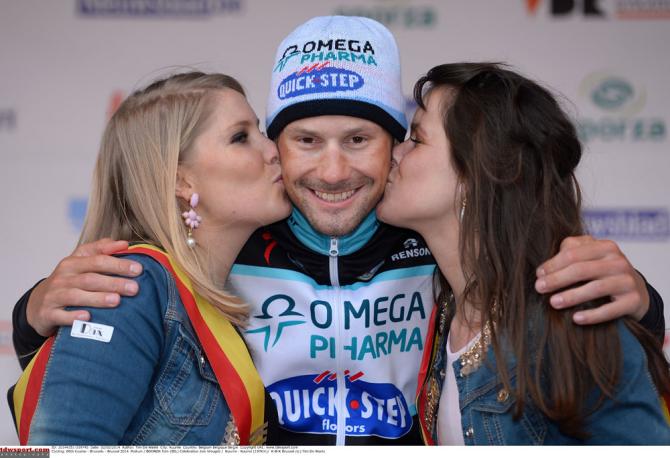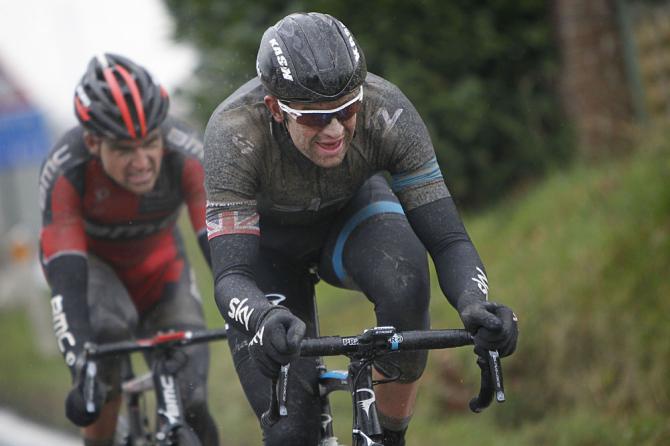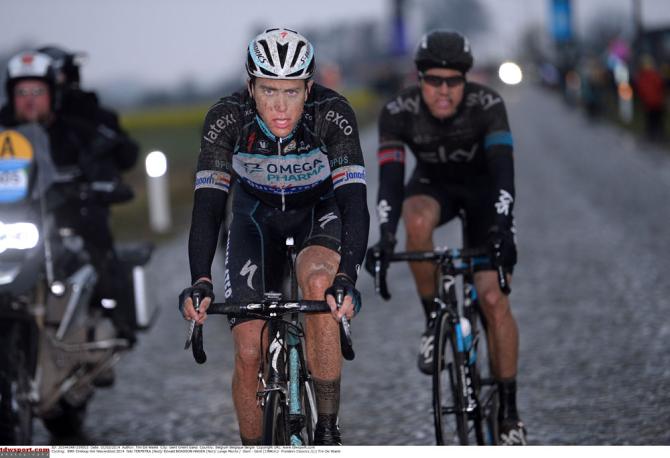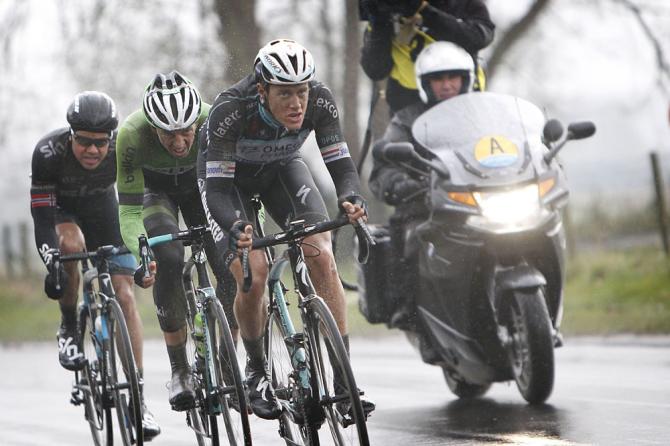10 conclusions from Omloop Het Nieuwsblad and Kuurne-Brussel-Kuurne
Analysis of Boonen's success, Team Sky's racing and the indication for Flanders




1. Radio-free Europe Tour
Boonen looks to learn from Omega Pharma's sprinting miscue in Oman
Stannard wins Omloop Het Nieuwsblad
Stannard picks his moment well at Omloop Het Nieuwsblad
Omloop Het Nieuwsblad: Vanmarcke laments lack of aggression from others
Sky count on collective strength at Omloop Het Nieuwsblad
Boonen wins Kuurne-Brussel-Kuurne
Boonen breaks record at Kuurne-Brussels-Kuurne
Omloop Het Nieuwsblad, so the truism goes, is not the Tour of Flanders. It’s 50 kilometres shorter, the final climb is much further from the finish and no serious Ronde contender is at peak condition a month out from the big day. On Saturday, however, it was a more recent difference between the two races that stood out.
When Niki Terpstra (Omega Pharma-QuickStep) went clear with Lars Boom (Belkin) and Edvald Boasson Hagen (Team Sky), it looked like the winning move, but then a curious thing happened. Terpstra opted to sit up, calculating that Tom Boonen would have a better chance of winning from a large group than he would of beating Boasson Hagen in the sprint himself. There was one major drawback: by that point Boonen was no longer part of the chasing group, and the only Omega Pharma-QuickStep rider remaining was noted non-sprinter Stijn Vandenbergh.
Terpstra had no way of knowing that Boonen had been dropped, because as a non-WorldTour race, radio earpieces are not permitted at the Omloop and his team car was still behind the chasing group. Boom’s subsequent puncture meant that the move may have struggled to stay clear regardless, but the point remains. If Terpstra found himself in a similar situation at E3 Harelbeke or the Tour of Flanders, for instance, he would have been instantly updated on Boonen’s whereabouts and taken a very different decision. There are deeply entrenched views on whether radio earpieces make for better races or worse races, but one thing is clear – they certainly make for different races.
2. No Pompeiana? No problem
On the eve of the Belgian opening weekend came confirmation that the climb of Pompeiana will not feature in Milan-San Remo after all and the race will revert, for this year at least, to the pre-2008 route. You’d get a very different opinion from the likes of Joaquim Rodriguez and Philippe Gilbert, of course, but the riders canvassed in Belgium over the weekend made little secret of their pleasure at that development.
“The oldest course is the nicest one,” Boonen said of Milan-San Remo, and the action at Het Nieuwsblad and Kuurne-Brussel-Kuurne supported that old adage that it is the riders themselves, rather than the route, who make a race.
Get The Leadout Newsletter
The latest race content, interviews, features, reviews and expert buying guides, direct to your inbox!
At Het Nieuwsblad and Kuurne, by contrast, there is no set “script” in the finale. Their flat run-ins are instead like blank pages, and allow plenty of scope for invention and creativity. Since 1982, Milan-San Remo’s Cipressa-Poggio combination has served a similar purpose – neither too difficult nor too easy, it is familiar but still always open to new interpretations. As Omloop and Kuurne showed this weekend, that’s never a bad recipe for a classic.
3. A change of approach at Team Sky?
Ian Stannard’s Het Nieuwsblad victory is an early-morale booster for Team Sky’s often-maligned classics unit. Although it should also be noted that they have performed strongly on the opening weekend in each of their previous four seasons only to fall flat over longer distances and at higher stakes in April. However Team Sky delivered a very cohesive team showing on Saturday, with third-placed Boasson Hagen, Luke Rowe and Bernhard Eisel all playing their part in support of Stannard.
Initially – and externally, it should be added – much of the blame for Team Sky’s low-key classics display last year was placed on their decision to train at Mount Teide rather than race at Tirreno-Adriatico or Paris-Nice beforehand. Yet although that experiment will not be repeated this year, the team’s riders and staff insist that it was not the root cause of their woes on the cobbles.
Directeur sportif Servais Knaven pointed to the fact that many of his riders fell ill before the Tour of Flanders as mitigation for their performance, while Ian Stannard made an interesting observation during the recent Tour of Qatar when he wondered whether the team’s policy of approaching the classics with multiple leaders, all on an equal standing, had proved counter-productive.
On Saturday, Team Sky appeared to enter the race with a more fixed hierarchy than normal, whereby Stannard was the acknowledged leader and the fast-finishing Boasson Hagen his foil, and it will be interesting to see if a clearer demarcation of roles leads to significant improvements at Flanders and Roubaix. Incidentally, Stannard’s win also marks out his territory on the team for Paris-Roubaix, where Bradley Wiggins is set to make his first appearance since 2011.
4. Being Tom Boonen
Boonen’s Kuurne-Brussel-Kuurne triumph was the 22nd classic or semi-classic victory since he got off the mark by winning E3 Harelbeke ten years ago. In that time, only two springs – 2010 and the injury-hit 2013 – have gone by without a Boonen victory on the cobbles. It’s a remarkable record, all the more so considering that he has been under the unrelenting focus of his home media and public throughout.
Gazet van Antwerpen’s Guy Van Den Langenbergh recently sat Boonen and Fabian Cancellara down together for an interview, published this weekend, and one exchange offered some insight into what life is like for Belgium’s most famous sportsman.
“I don't go to the supermarket because everybody is always looking at what I am buying when I go there,” Boonen said, to the horror of Cancellara.
It’s the kind of attention that has proved far too much for more than one young Belgian rider over the years, and Boonen has experienced his own share of turbulence during his career, but he has also shown remarkable endurance and resilience. At 33 years of age, he is still winning, still smiling – and still the man to beat on the cobbles.
5. The Empire Strikes Back
“The Tour of Qatar is not the Omloop Het Nieuwsblad,” Sporza television co-commentator José De Cauwer said when it emerged that Tom Boonen had been dropped on Saturday afternoon, suffering in the cold conditions. Indeed, on a disappointing afternoon for Omega Pharma-QuickStep, Niki Terpstra was one of the few to perform to his expected level and it left some wondering if the team’s domination in Qatar had been over-stated.
The Omega Pharma-QuickStep response arrived a day later at Kuurne-Brussel-Kuurne and in emphatic fashion. Stijn Vandenberg set a fierce pace on the Oude Kwaremont, and by the summit there were five black jerseys in the leading group of ten. Over the next 60 kilometres, with help from a strong Belkin trio, they held off the chasing peloton and Boonen – inevitably – won the group sprint.
Team Sky directeur sportif Servais Knaven noted that the best teams have their riders in the right position before crucial climbs nine times out of ten, and after their Omloop disappointment, QuickStep were not going to miss out again. They don’t always win the classics (though they often do), but year after year, QuickStep set the standards that everyone else much match. It would be a surprise if that wasn’t the case again in 2014.
6. How soon is now for Van Avermaet?
Greg Van Avermaet’s failure to beat Ian Stannard at Het Nieuwsblad will only give further succour to those who look to dismiss the Belgian as a nearly man – his 2011 Paris-Tour victory, still a classic no matter what the WorldTour calendar might say, is often and unfairly overlooked – but there are still some positives to be drawn from his second place finish.
In the finale, Van Avermaet showed more confidence and initiative than he has done in such situations in the past. He forced the pace on the Leberg, led the chase of the Terpstra-Boom-Boasson Hagen group, and then seized the chance to launch the winning move with Stannard.
For the second year running at Omloop, however, the devil was in the detail. Last season, he suffered an untimely fringale on the run-in to Ghent. This time around, like many others, Van Avermaet was short of a layer of clothing when the heavens opened after the midway point, and short of a glove come the finish. Small but vital details that decide races. “My body didn't react anymore as I thought it would react,” he said of the sprint, where he was surprisingly beaten by Stannard.
7. Vanmarcke and Belkin bubbling under
Sep Vanmarcke didn’t come away with a win from the opening weekend in Belgium but he did enough over the two days to suggest that he will be a major factor at the Tour of Flanders and Paris-Roubaix this year.
He seemed one of the strongest men in the race on Saturday, and was equally prominent at Kuurne, where he was a driving force in the Belkin/QuickStep alliance that decided the race before helping himself to third place at to finish.
His cameo on the Taaienberg during Omloop was particularly striking. The climb is Boonen’s traditional early-season test site, but this time it was Vanmarcke who issued the silent statement of intent by hammering his way up the smooth gutter on the right hand side of the road and stretching the peloton. Eight years Boonen’s junior, Vanmarcke seems the man most likely to inherit his crown as Belgium’s top classics rider – although Kuurne-Brussel-Kuurne showed that there is no abdication planned just yet.
Lars Boom was already in fine shape at the Tour of Qatar and but for his untimely puncture and an agonisingly slow wheel change, the finale of Het Nieuwsblad could have had a very different complexion. Belkin’s strong team display at Kuurne and young Moreno Hofland’s second place finish are further encouraging signs for the Dutch squad.
8. FDJ.fr an emerging classics force
Some WorldTour teams have the tendency to treat the Belgian calendar as though it contains fixtures to fulfill rather than races to win, but as befits a double Paris-Roubaix winner, FDJ.fr manager Marc Madiot has never made any secret of his predilection for the cobbled classics. Prior to his retirement, Frédéric Guesdon was always a redoubtable presence on the pavé but he often seemed to be ploughing a lone furrow at FDJ. This year, it seems as though Madiot is finally on the cusp of developing a classics team commensurate with his ambitions.
FDJ’s young guns probably still a couple of years away from challenging for the Tour of Flanders or Paris-Roubaix, but they were audacious at Omloop Het Nieuwsblad. Yoann Offredo (who at 27 is admittedly no longer a classics neophyte) and Arnaud Démare both had the legs and the gumption to make it across to Terpstra and Boom’s attack, while former junior world champion Johan Le Bon exceeded expectations with his aggressive showing. “Before, we used to be spectators, but now we’re actors. We’re in the game more,” Madiot told L’Équipe.
9. Phinney takes a step forward
When Taylor Phinney (BMC) said in January that he had just enjoyed the best and most consistent winter of his professional career, it could easily have been dismissed as the kind of thing every cyclist tells the press – and perhaps tells himself – at the outset of every new season.
However the young American’s performances since have borne out his assertion. Already the winner of the time trial and general classification at the Dubai Tour last month, Phinney was very much to the fore at Omloop Het Nieuwsblad on Saturday.
Phinney’s brief was to work for Greg Van Avermaet. He was instrumental in helping to set up his teammate’s attack in the finale and his eventual seventh place capped off his best display on the cobbles since turning professional. Crashing out of Kuurne-Brussel-Kuurne took some of the gloss off the weekend. He needed six stitches in his knee but x-rays showed he did not fracture any ribs. He will no doubt face a painful week before starting Paris-Nice but his spring cobbled Classics campaign remains on track.
It now remains to be seen what progress Phinney can make in April as part of new manager Allan Peiper’s more streamlined BMC classics squad, where there are fewer potential leaders than before but perhaps a greater sense of purpose.
10. Not quite a dress rehearsal
More than one team manager this weekend described Het Nieuwsblad as a dress rehearsal for the Tour of Flanders but it’s worth noting too that a number of the leading players are saving themselves for the big occasion. Fabian Cancellara, Peter Sagan and Filippo Pozzato were among the contenders for April honours to miss the Opening Weekend, mindful perhaps that the last man to win the Omloop and a monument in the same year was Johan Museeuw in 2000.
Meanwhile, the riders who did show up were not yet in full voice, at least according to Boonen, who said: “If you are 100 percent for Omloop, you can forget about the Classics later. You can be up to 80 or 85 percent of your possibility, that is all.” Not so much a dress rehearsal for the classics, then, as much a teaser trailer. Three weeks from Milan-San Remo and five from the Tour of Flanders, there is still plenty of scope for late rewrites to the script.

Barry Ryan was Head of Features at Cyclingnews. He has covered professional cycling since 2010, reporting from the Tour de France, Giro d’Italia and events from Argentina to Japan. His writing has appeared in The Independent, Procycling and Cycling Plus. He is the author of The Ascent: Sean Kelly, Stephen Roche and the Rise of Irish Cycling’s Golden Generation, published by Gill Books.